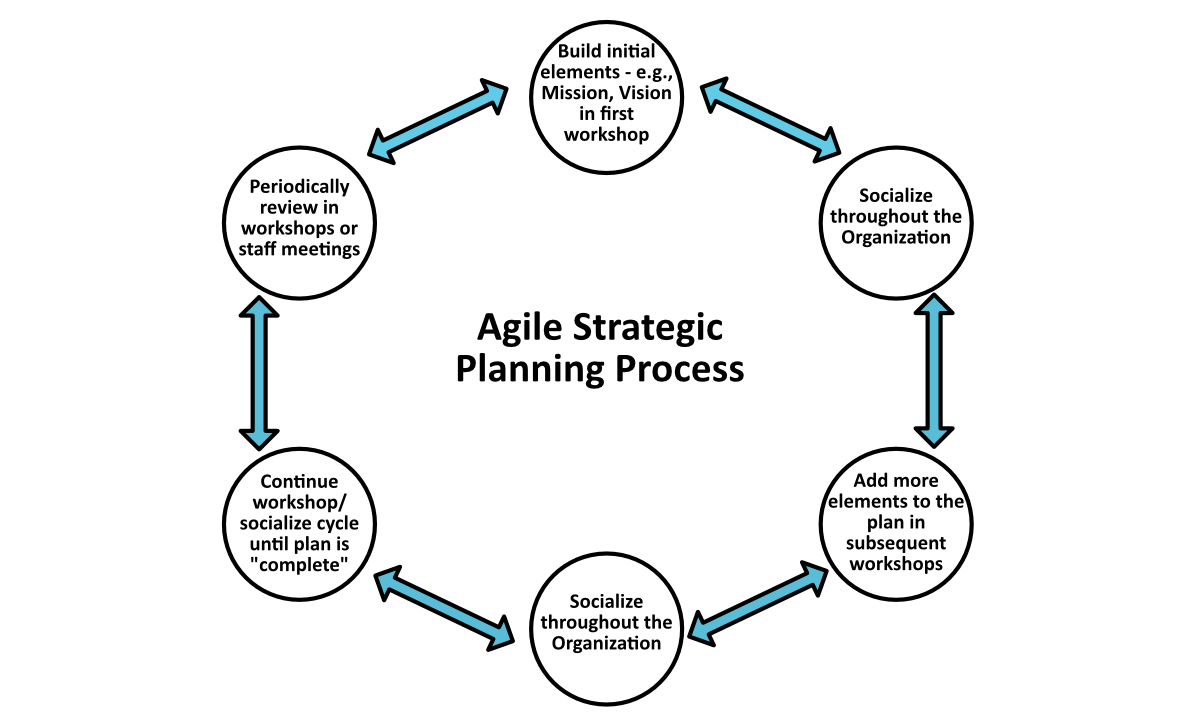July 2022 - The FoCuSeD™ Facilitator Newsletter

An Agile Strategic Plan is a Process, Not an Event | Gary Rush, IAF CPF | M
I am a strong supporter of Strategic Planning, but, as I mentioned in two previous posts (see “Swift” Strategic Planning and Applying Agile Concepts to Strategic Planning), Strategic Planning needs to be a process that an organization shares with its employees – or better yet, involves them in its development. When I facilitate employee satisfaction workshops, the number one complaint is, “We don’t know how what we do fits into the strategic plan.” General Eisenhower said, “Plans are nothing, planning is everything.” In other words, Strategic Planning should not be an event; it should be a process.
An Event produces “Shelf Ware”
Senior Leaders frequently develop detailed Strategic Plans at sequestered off-site retreats. The retreat concept is flawed because it requires an intensive, concentrated effort and assumes that the world is static. They develop their plan once a year, publish it, and place it on the shelf becoming “shelf ware”. The problem is that the world does not stay static until the next planning off-site retreat; it is constantly evolving. But there is a better way.
An Agile Strategic Planning Process
An Agile Strategic Planning Process focuses a group of people to develop a strategic plan by building the plan, using short, structured, facilitated workshops that "peel away the layers." A complete strategic plan is not developed in one workshop; instead, you start with an initial workshop then you socialize the plan with the organization and continue with subsequent short workshops socializing the evolving plan until completed. You will build highly effective plans without losing group energy and you will turn strategic planning from an event into a process.
First of all, let me establish some basic principles that I follow. An Agile Strategic Plan must:
- Be simple, easily communicated, and understandable. I prefer it to be 4 pages or less (the length of the U.S. Constitution) and I don’t include excessive metrics – those are tactical.
- Include “SMART” – Specific, Measurable, Achievable, Relevant, and Time-based – Objectives. Strategic Plans fail with poorly defined objectives because organizations don't know where they are headed. Keep asking, “How would you know that…?” It helps find what to measure.
- Be alive, never static or "cast in stone". The world changes every day.
- Look out 20 years or more. The further out the Vision, the more the organization is driving its industry - you lead or follow.
- Constantly evolve. Continuous review and socializing ensures direction.
Structured Facilitated Workshops
You develop the plan in a series of structured, facilitated workshops by conducting a 4- to 8-hour workshop every two weeks. You complete elements of the plan (e.g., Mission, Vision) in the first workshop and add additional elements in subsequent workshops. It takes from 3 to 8 workshops to complete the Strategic Plan. The workshop process then continues, because it is constantly evolving (e.g., every 3 to 6 months) to continue updating the plan. The structured agendas for the workshops vary depending on how much you accomplish, or which "hot" topics arise between workshops. Between workshops, participants socialize what they worked on with the rest of the organization. Socializing the evolving plan in between helps engage all people, communicate the plan, and enable plan adjustments, as needed, in subsequent workshops.
Periodic, short workshops help by:
- Maintaining the energy. Four to eight hours is easier for participants than three 8-hour days.
- Validating the plan through implementation and socializing. This helps spread awareness across the organization.
- Alleviating complaints from decision-makers. Planning becomes a part of the job instead of impacting the job by being away for longer periods of time.
- Beginning a process that makes the plan evergreen – never static or cast in stone. Strategic Planning ceases to be an event – it is now a process.
Remember – Keep it Simple (KIS).
Summary
Strategic Planning is most effective when it is a process, rather than an event (i.e., Agile Strategic Planning). Developing the plan in short, iterative, structured workshops is successful because it enables socialization of the Strategic Plan, and it enables the organization to “test” and adjust the plan while in development.
Gary Rush, IAF CPF | Master teaches and facilitates Strategic Planning.

